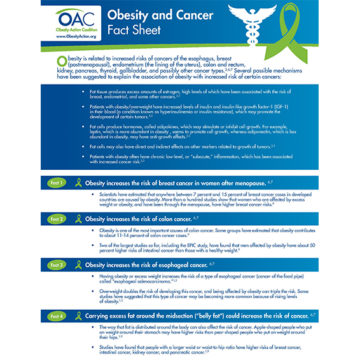Understanding Prediabetes and Excess Weight Brochure


This brochure is designed to help individuals affected by excess weight understand the high risk of developing prediabetes. Many people are not aware they have prediabetes until symptoms of type 2 diabetes begin to show. Through this educational brochure, we hope to provide a better understanding of prediabetes and how it relates to excess weight by addressing the following:
- Evaluating excess weight
- Defining prediabetes
- Risk factors for prediabetes
- Testing for prediabetes
- Reducing risk of developing type 2 diabetes
How Does Excess Weight Affect a Person’s Health?
Excess weight, obesity or severe obesity can affect a person’s health in many ways.
Obesity is a disease in which excess body fat has accumulated to the extent that it may have an adverse effect on a person’s health. Obesity also increases a person’s risk of developing hypertension, type 2 diabetes, certain types of cancer, osteoarthritis, stroke and dyslipidemia (abnormally high cholesterol in the blood).
Setting realistic goals about nutrition, physical activity and weight-loss to support lifestyle changes can delay or prevent the onset of type 2 diabetes.
Since excess weight can affect a person’s health in many ways, it is therefore important to be able to evaluate how much excess weight a person has. There are many methods of measurement that can be used; however, the most often used method is calculating the body mass index (BMI). BMI is a number calculated by dividing a person’s weight in kilograms by his or her height in meters squared. There are four weight status categories (underweight, normal weight, overweight and obesity). To calculate your BMI and determine your weight status category, click here.
What is Prediabetes?
Prediabetes is the state that occurs when a person’s blood glucose (sugar) levels are higher than normal, but not high enough for a diagnosis of diabetes. Prediabetes can also be referred to as Impaired Glucose Tolerance (IGT) or Impaired Fasting Glucose (IFG).
Individuals with prediabetes have an increased risk of developing:
- Type 2 diabetes
- Hypertension
- Stroke
Approximately 88 million American adults – more than 1 in 3 – have prediabetes. Of those with prediabetes, more than 84% don’t know they have it.
Who is at Risk for Prediabetes?
People who are overweight and 45 years or older should be checked for prediabetes. People of normal weight and 45 years or older should ask their healthcare professional if testing is appropriate. Healthcare professionals may recommend testing adults who are younger than 45 years and overweight if they have any other risk factors for diabetes or prediabetes, such as:
- High blood pressure
- Low HDL cholesterol and high triglycerides
- Family history of diabetes
- Gestational diabetes or delivering a baby greater than nine pounds
- Belonging to an ethnic or minority group at high risk for diabetes
- Physical inactivity
- A1C levels greater than or equal to 5.7 %, IGT, or IFG on previous testing
- History of Cardiovascular Disease
- Women with polycystic ovarian syndrome
- Other clinical conditions associated with insulin resistance
As there are not usually signs or symptoms for prediabetes, it is often discovered during a routine physical examination with basic screening for fasting blood sugar levels.
A normal sugar level is below 100 mg/dL. If it’s 100 to 125 mg/dL, this indicates that the individual has IFG or prediabetes.
How Does a Person Test for Prediabetes?
There are a variety of blood tests that may indicate whether someone has prediabetes. Let’s take a look at two of the most common tests and see what different results could mean.
Fasting Blood Sugar Chart
| Sugar level | Indicates |
| Under 100 mg/dL | Normal |
| 100 to 125 mg/dL | Prediabetes |
| 126 mg/dL or higher on two separate tests | Diabetes |
Fasting Blood Sugar Test
The amount of sugar in the blood naturally fluctuates, but should stay within a normal range. The preferred way to test blood sugar is after fasting overnight for at least eight hours. A fasting blood sugar level less than 100 milligrams of sugar per deciliter of blood is considered normal. If fasting sugar levels are still 100 to 125 milligrams, this indicates prediabetes.
Oral Glucose Tolerance Test
(2-hour Post-Glucose Challenge)
This test can be done by visiting a lab or a healthcare professional after at least an eight-hour fast and drinking a sweet liquid that contains a lot of sugar (75 grams). Blood sugar levels will be measured before drinking the liquid, one hour later and again two hours later. If blood sugar levels reach between 140 and 199 mg/dL after two hours, this indicates prediabetes.
Criteria for Diagnosing Diabetes
- A1C = 5.7 -6.4% (prediabetes)
- A1C = 6.5% (diabetes)
- Fasting plasma glucose = 126 mg/dL
- 2 hour plasma glucose = 200 mg/dL during an oral glucose tolerance test
How Can Someone with Excess Weight and Prediabetes Reduce the Risk of Developing Type 2 Diabetes?
Having prediabetes exposes an individual to a higher risk for type 2 diabetes. However, this doesn’t mean that everybody with prediabetes will eventually develop type 2 diabetes. Studies have shown that the risk of developing type 2 diabetes can be reduced by losing 5 to 7% of body weight through diet and increased physical activity.
Healthy Meal Plan
Weight-loss occurs when people burn more calories than they consume. A calorie deficit of 500 calories a day can result in weight loss of approximately one pound per week. Writing down the food, portion size and calorie amount in a food diary can help people become aware of what they consume and can provide evidence of calorie intake.
People with prediabetes may benefit from limiting poor quality carbohydrates in their diet, like desserts, sugar-sweetened beverages, and refined bread products. Rather, people with prediabetes should be focusing on high-quality, high fiber carbs, such as whole fruits, vegetables, whole grains, and beans/legumes.
Control your portion of carbohydrates at meals by building your plate with 1/4th (quarter plate) of carbohydrates and pair with 1/4th plate protein and a 1/2 plate of non-starchy vegetables.
Exercise Program
Regular exercise helps maintain weight-loss and prevent regain. It also improves glycemic control (measurement of the effects of carbohydrates on sugar level) and reduces the risk of cardiovascular disease.
A goal of 30 to 45 minutes of moderate exercise most days per week should be set. Exercise does not need to occur in a single session to be beneficial. Dividing the activity into multiple, short episodes produces similar benefits and is often more achievable.
Fortunately, it doesn’t take dramatic weight-loss to reduce the risk for prediabetes or to improve one’s health. Losing just 5% of one’s weight can make a significant difference in reducing the risk of type 2 diabetes. Moderate weight loss can also help delay or prevent diabetes-related complications and make sugar control easier in prediabetes.
In addition to incorporating a healthy meal plan and exercise program, today’s world of technology and social networking may enhance a person’s ability to monitor their health. There are many online and app-driven resources, such as food journals, calorie trackers, exercise tools and more available online, for your smartphone and more!
One of the most important things for a person with prediabetes to do is make useful, concrete decisions on lifestyle changes and exercise with the help of his or her healthcare team. People with prediabetes should be proactive and ask their healthcare professionals for resources to help them achieve their lifestyle goals.
What are the Consequences of Diabetes?
When the sugar remains in the blood instead of the cell where we want it, there is damage to nerves and blood vessels, usually in the feet, hands, kidneys and eyes. Other consequences of diabetes include:
- Neuropathy (nerve damage, especially in extremities)
- Nephropathy (kidney disease)
- Retinopathy (vision problems, blindness)
- Cardiovascular disease (heart disease and increased risk of strokes)
- Erectile dysfunction in men and decreased sexual desire in both men and women
- Depression
- Amputation
How Does the Body Manage Excess Glucose?
During a fast, or between meals, the body may rely on stored glucose in the liver – glycogen – for energy. Glycogen is composed of several thousand glucose molecules held together with water molecules. If the fast is very long, however, the body may instead use amino acids or fatty acids to help with its metabolic processes.
After we eat a meal, the processes of chewing and chemical digestion produce glucose (sugar), which is the most readily available for of fuel for our organs – especially muscle and brain tissue. In a normal state, the glucose produced from these digestive processes enters our cells to help with other metabolic processes.
Insulin acts a key that unlocks the door to let glucose in to feed our cells. When insulin is present, it also turns off the process of using glycogen from the liver to ensure that the glucose level does not rise further after a meal. In fact, insulin reduces blood glucose by collecting any excess glucose that is present in the bloodstream so that it can be stored as glycogen for future use.
However, if the adequate amount of insulin is not available, as is the situation in diabetes, then this glucose is unable to enter cells. Instead, the glucose remains in the bloodstream in a higher than usual concentration. This condition is referred to as elevated blood glucose or hyperglycemia.
How can You Learn More about Prediabetes and Excess Weight?
To see if you are at risk for prediabetes, please schedule a visit with your healthcare provider for more information. To help you prepare for your visit, we’ve provided you with some sample questions that you may be asked by, or sample questions for, a healthcare provider.
Sample Questions
Questions a Healthcare Professional May Ask You
- When was the last time you saw a healthcare professional?
- When did you last have blood work completed?
- Are you currently taking any medications?
- Have you been previously diagnosed with any medical conditions?
- How physically active are you on a weekly basis?
- Can you describe your eating habits?
- Does anyone in your family have diabetes?
- Do you feel fatigued or tired more than usual?
- Do you have dry mouth or find yourself drinking fluids often?
- Do you find yourself urinating often?
- Do you have blurred vision or experience headaches?
- Have you recently gained weight?
Questions You Should Ask a Healthcare Professional
- Does your office have a registered dietitian on staff with diabetes and obesity training?
- Do you have diabetes educators available?
- What kind of tests do you use to determine if I have prediabetes?
- How do you prefer to treat someone with prediabetes?
Special thanks to Holly Lofton, MD, for assistance in creating this brochure and thank you to the Yale Rudd Center for Food Policy and Obesity for providing the photography found in this brochure.
The information contained in the Understanding Prediabetes and Excess Weight Brochure is not a substitute for medical advice or treatment from a healthcare professional. The OAC recommends consultation with your doctor and/or healthcare professional.
by Kendall Griffey, OAC Communications Manager Spring 2024 We have officially kicked off Your Weight Matters Regional…
Read Articleby Sarah Ro, MD; and Young Whang, MD, PhD Fall 2023 Mary, a postmenopausal woman with a…
Read Articleby Rachel Engelhart, RD; Kelly Donahue, PhD; and Renu Mansukhani, MD Summer 2023 Welcome to the first…
Read Article









